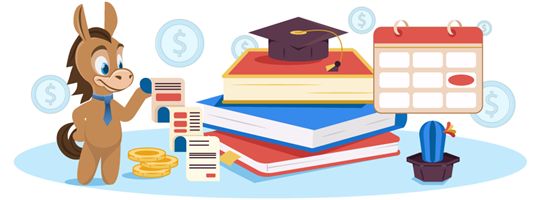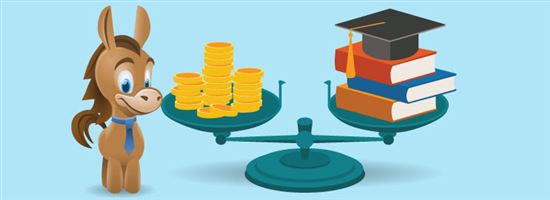Study: Average Student Loan Payment
The average student carries $37,172 in student loan debt, with a monthly payment of $351. Read on to learn about student loan debt facts and trends.
 |
| © CreditDonkey |
Student loan balances are reaching astronomical heights. Putting it into perspective, they are second only to mortgage debt. This debt makes it hard for graduates to do anything but just "get by."
Read our report to learn more about this issue that could put your financial future at risk.
The Average Student's Student Loan Debt
Student loan payments keep increasing. Unfortunately, starting wages haven't had the same luck. This can pose a problem for new graduates.
- What is the average student loan payment?
The average student pays $351 per month. That sounds like a lot, but student loan balances paint a different picture. We've seen a 280% increase in student loan balances since 2005. But we've only seen a 50% increase in student payments. In other words, those high balances aren't getting paid down very fast. - How much student debt does the average student have?
The average student carries $37,172 in student loan debt. Unfortunately, starting wages aren't as high. Students who don't stay on top of the debt can damage their credit quickly.Credit is one of the most important tools that you have for your future. One of the worst things you can do is to let your federal student loans enter default. Default occurs when your federal student loan payments are past due for 270 days. After 360 days the loans will enter collections with the federal government. As a result, your credit may drop by up to 200 points. - What is the average student debt for a master's degree?
The average post-graduate doesn't leave college with just a Master's degree. He/she also leaves with an average of $58,000 in debt. Ten percent of graduate students have more than $100,000 in debt. - What is the average cost of college tuition?
How much you pay for college tuition depends on where you live. Attending an in-state public college has its benefits. It costs an average of $7,110 to stay in state and attend a public school. If you prefer a private school, get ready to pay much more. The average private school tuition is $32,400. Cost of attendance will also depend on which state you go to college. College grads in Utah can expect to have only $7,545 in debt whereas students in New Hampshire can expect to have roughly $27,167 in debt by graduation. - What percentage of college students have student loans?
Almost 70% of college students leave college with some type of loan. This number isn't as alarming as the amount of debt, though. The percentage of college students with debt has risen modestly. The amount of debt they carry, though, has risen drastically.
Basic Student Loan Facts
 |
| © CreditDonkey |
Knowing the basic facts about student loans can help you start on the right foot. Too many students just take whatever loans they are offered. They don't find out the terms or consequences until it's too late. We aim to help prevent this from happening to you.
- Can anyone get a student loan?
To a point, yes, anyone can get a student loan. How much you get depends on your circumstances. However, you do need to meet some basic qualifications:- You must be a citizen with a social security number (eligible noncitizens may qualify too)
- You must have a high school diploma and enroll at least part-time in an accredited college
- You must not have any defaulted federal loans
- You must demonstrate financial need by completing the Free Application for Federal Student Aid
This criterion pertains to federal student loans. Private banks may provide private student loans as well. They set their own criteria, though. They will generally look at your credit score and debt ratio to determine your eligibility.
- You must be a citizen with a social security number (eligible noncitizens may qualify too)
- How do you take out a student loan?
Any student who applies to a college should complete the Free Application for Federal Student Aid. The federal government uses this application to determine your need. But your state and college financial aid departments use it as well. The form becomes available around October 1st each year. It is usually due by June of the following year. - How long is the grace period on student loans?
Generally, you have 6 months of no payments after graduation. Your standard payment begins during that 7th month. If you make other arrangements, this may change. - How is student loan interest calculated?
Student loan interest is compounded daily. On your loan papers, you'll see an annual interest rate. Let's say it says 5% for simplicity's sake. You would pay .0134% per day.The easiest way to calculate your daily interest accrual is with this simple equation:Total loan balance x Interest rate / by 365 days = daily interest rate*
*Remember if you have different loans with different interest rates this will need to be done with each loan.
On $10,000 in student loans, you'd pay $1.34 per day or $40 a month in interest. Any payment you make first covers the accrued interest. The remaining payment helps to decrease your principal balance.
- How long does it take to pay off student loans?
The standard repayment plan allows you to pay off student loans in 10 years. The reality is, however, that this doesn't always happen. The average student takes 21 years to pay off their student debt. Keep in mind there are many repayment options it is always best to speak with your loan servicer. - How many people are delinquent on their student loans?
According to the U.S. Department of Education, 593,000 borrowers of the 5.2 million that entered repayment defaulted on their student loans. That's 11% of the total student loan borrowers.
The Ins and Outs of Each Loan Type
Each student loan program has different limits. We help set the record straight here. Again, the more you know, the better-informed decisions you can make.
- How much can you get on a federal student loan?
Students may receive loans up to the total cost of attendance. This means tuition, room and board, transportation, and personal expenses. Here's a breakdown of each program:- Stafford loans for undergraduate dependents: $5,500 freshman year, $6,500 sophomore year, and $7,500 both junior and senior year
- Stafford loans for independent undergraduates: $9,500 freshman year, $10,500 sophomore year, $12,500 both junior and senior year
- PLUS loans for both undergraduates and graduates: Any amount left after any other financial aid options are exhausted
Note: Stafford loans can be subsidized or unsubsidized. The subsidized limits are lower than unsubsidized. As a freshman, you can have up to $3,500 in subsidized loans. The remaining $2,000 is unsubsidized.
- Stafford loans for undergraduate dependents: $5,500 freshman year, $6,500 sophomore year, and $7,500 both junior and senior year
- How much can you get in private student loans?
Private student loans have a unique maximum. It's the cost of attendance minus any federal aid you receive. But you must qualify for these loans. Lack of federal aid isn't a guarantee of approval for private student loans. - How much money can a student borrow for graduate school?
The federal government considers graduate students to be independent. This means you qualify on your own. This could help increase the amount of financial aid you receive.Today, graduate students can receive up to $20,500 in unsubsidized loans per year. You may receive a lifetime aggregate amount of $138,500.
If you require more than that, you can apply for a PLUS loan. Keep in mind, the DOE will perform a credit check for eligibility.
- Is there a limit on the amount of student loans you can get?
Along with the yearly limits, there is an aggregate or lifetime limit for all loans. Undergraduates can borrow a maximum of:- $31,000 for dependent students
- $57,500 for independent students
Graduate students, as we discussed above, can borrow up to $138,500 over their lifetime. Private student loans typically allow between $75,000 and $120,000 over a lifetime.
Note: If you exceed your lifetime maximum, you can pay the loan balances down. You can then apply for further loans in the future.
- $31,000 for dependent students
- What is a Stafford Loan?
When you talk about federal student loans, you are likely talking about Stafford Loans. They are the most popular federal financing option. They are available to graduates and undergraduates. They offer fixed interest rates and a low origination fee. You can also receive subsidized and unsubsidized Stafford Loans. - How are subsidized and unsubsidized student loans different?
Student borrowers demonstrating financial need may receive subsidized loans. The government covers the interest charges while you are in school. They even pay it while the loan is deferred.Unsubsidized loans don't offer interest payment coverage. But you don't have to demonstrate financial need to qualify, either.
Managing Student Loan Debt
Once you graduate, you have options. Your goal should be to pay your loans down as fast as possible. We know that's not always feasible, though. Discover the options available to you below.
- How do you get out of student loan debt?
Want the easy answer? Make your standard payments and you'll be out of debt in 10 years. Many borrowers can't afford the standard payment, though. In this case, you'll need a repayment plan. There are several options:- Income Based Repayment (IBR): You'll pay a specific percentage (10-15%) of your discretionary income. The maximum payment is your calculated standard payment. The government may pay some of your interest, at least for the first 3 years.
- Pay as You Earn Repayment (PAYE): If you took out your loans after October 1, 2011, you may qualify to pay 10% of your discretionary income. The maximum payment is your calculated standard payment. The government may subsidize your interest on this program.
- Revised Pay as You Earn Repayment (REPAYE): You only pay 10% of your discretionary income. The difference is there is no maximum payment. As you make more money, your payments increase accordingly.
- Income Contingent Repayment (ICR): This is the only plan that allows you to include Parents PLUS loans. You pay 20% of your discretionary income on this program. The government does not subsidize any interest on this plan.
Remember under all these plans once you have successfully made the required 20 or 25 years of payments your loans will be forgiven.
- Income Based Repayment (IBR): You'll pay a specific percentage (10-15%) of your discretionary income. The maximum payment is your calculated standard payment. The government may pay some of your interest, at least for the first 3 years.
- What options are available to defer student loan payments?
Life happens. You graduate with great intentions, but then life throws you a curveball. Your student debt won't just disappear, though. Don't just default and risk serious consequences. Instead, see if you can defer it.Economic hardship and unemployment typically allow for short periods of deferment. You may be eligible for a 6- to 12-month deferment with the option to renew it for up to 3 years. You will also have the option for a forbearance which can be used for multiple financial stresses up to 3 years.
Keep in mind, the interest continues to accrue even in forbearance. You can choose to pay it as it accrues or add it to your loan balance.
- What is student loan forgiveness?
If paying your student loans sounds exhausting, don't give up yet. There are many options for student loan forgiveness. Professionals in certain industries may have their loans forgiven after 10 years. These professions include teachers, nurses, and those in public service. This doesn't happen automatically, though. You must apply with the Department of Education. - How do you keep track of your federal student loans?
The federal government makes it easy to stay on top of your federal student loans. You can access your account in the National Student Loan Data System. In this system, you can view all of your federal loans and grants along with the status of each.
Demographic Details About Student Loans
The average student loan debt figures are nationwide. Here we look at the states with the highest and lowest amounts of debt.
- Which states have the highest student loan debt?
According to TICAS, New Hampshire and Pennsylvania have the most student loan debt. They have $36,101 and $34,798, respectively. - Which states have the lowest student loan debt?
The states with the lowest amount of debt are Utah and New Mexico, with $18,873 and $20,193, respectively. However, to say these debts are low is a bit of a stretch.
You can log on to the Federal Student Aid website to make use of the loan calculator to estimate your payments.
The Bottom Line
Student loan debt may be a necessity if you want to attend college. There's nothing wrong with it. Just understand your loans. Don't just take them because they are offered. Ask about the terms and what is expected after graduation. Then you can make an informed decision regarding your education and the loans necessary to make it happen.
Sources and References:
Write to Kim P at feedback@creditdonkey.com. Follow us on Twitter and Facebook for our latest posts.
